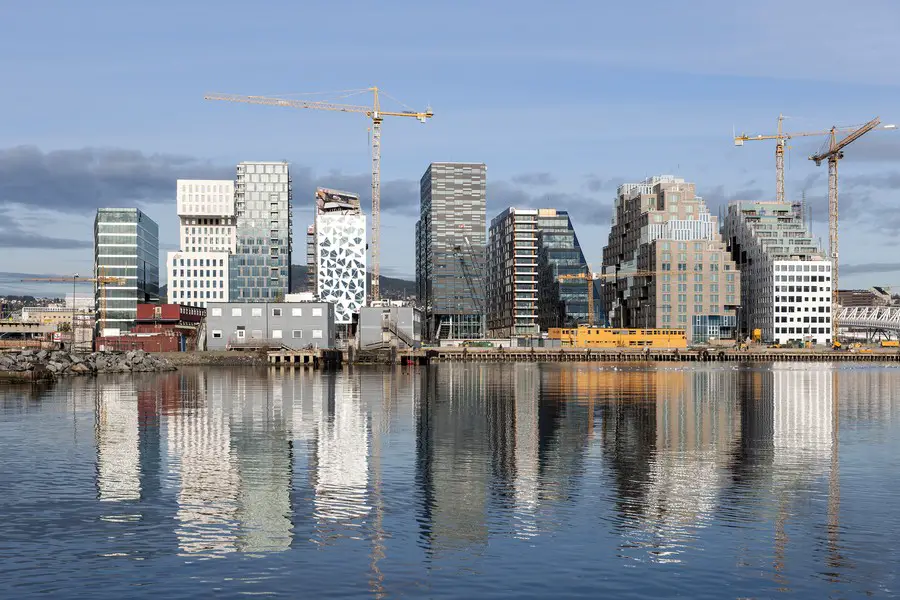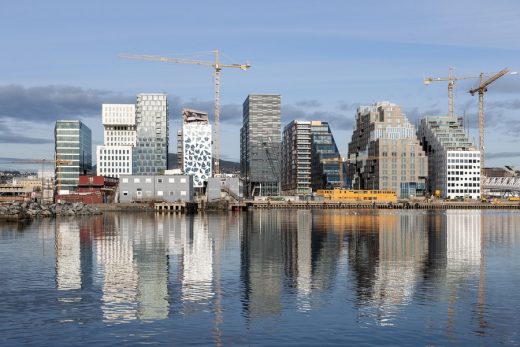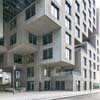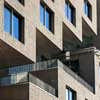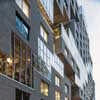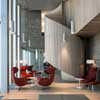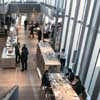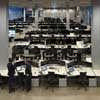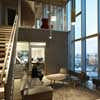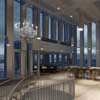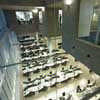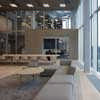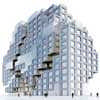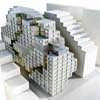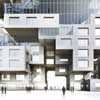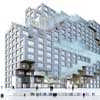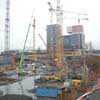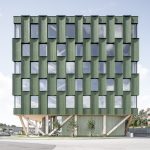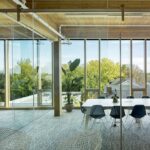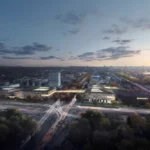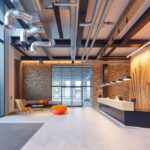DnB NOR Headquarters, Norway HQ Building, Oslo Office Property, Image
DNB Bank Headquarters, Oslo
Architecture Development by Oslo S Utvikling (OSU), Norway – design by MVRDV
13 Dec 2012
DNB Bank Headquarters Oslo
Design: MVRDV, Architects
MVRDV completes DNB Bank Headquarters main building in Oslo
This new building by MVRDV sits within an exuberant new group on the Oslo waterfront. Each building is in a contemporary style and there is a dense urban grain to the development. The bank building is certainly dynamic in external expression, almost like an inversion of Hertzberger’s celebrated Centraal Beheer. The diagonal crevasse is intriguing, attractive from outside but at many points of the day surely limiting natural light to some internal spaces.
Project Description
Rotterdam, 13th of December – The central building of DNB’s new bank headquarter cluster developed by Oslo S Utvikling (OSU) is completed. The MVRDV designed main building has 17 unique floors and a surface of 36,500m2. The pixelated volume based on small-scale working units adapts to the various influences of the urban context, combining an efficient and flexible internal organisation with a variety of specific communal spaces such as the main entrance lobby, a transparent trading floor, a sheltered public passage, respect for urban view lines and collective terraces overlooking the fjord to the south. The glass and brick exterior expresses both the transparency and stability of DNB as a modern financial institution.
The pixel is based on the ideal workgroup of the bank and reclines whenever necessary:

photo : Jiri Havran
The development of the new headquarter cluster is a strategic operation concentrating the DNB offices formerly spread out over Oslo at one location, aiming for synergy and a clear identity. The objective was to translate the social and democratic character of the organisation into a building with excellent working conditions and spatial qualities that would stimulate efficiency, identity and collaboration.
The design is based on an ideal work group of the bank, a pixel of 6×6 metres, whose versatility permits adaptation to the flexible nature of the organisation. Besides more than 2,000 flexible work spaces the building contains a panoramic 140 seat canteen on the top level, the executive lounge with a view over the fjord, the board room, in the heart of the volume DNB´s trading room with 250 work stations, and the main entrance with the reception and access to the concourse that connects to the two neighbouring volumes. The collective spaces are connected by a staggered continuous internal route of collective terraces, all being executed as glass pixels, encouraging informal meetings and communication between employees.
This route meanders from the reception upwards through the building, connecting all 17 levels office levels with the communal areas. A series of wooden stairs and bridges allow employees to switch levels or even to walk up to the canteen on one side of the building and down on the other side. The route accommodates communal areas to the office floors and is made homely with a series of pantries, informal meeting areas, reading-rooms, lounges and fire places. It gives access to the various outdoor terraces and roof gardens. All these collective spaces offer views to the surroundings and transparency from outside. The route is naturally ventilated and has a high performance glass fit for the cold Norwegian winter.
The DNB building is part of the MVRDV Barcode masterplan Operakvartet:
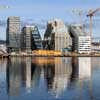
image : Jiri Havran
The generic office floors recline and are recessed in various places to answer to the urban context creating communal indoor and outdoor areas and outstanding daylight conditions. At street level the building volume is opened to give space to sheltered entrance zones, and intersected by a public passage creating a public route between Oslo Central Station and the fjord. The pixelated design allows this specific response whilst being highly efficient and flexible. As a result, every floor of the building is both unique and generic: the pixelated volume makes the generic specific.
The structure is conceived as a steel rack wrapped in a brick skin, covering all exterior terraces, walls and ceilings with bricks, which adopts Norwegian environmental standards and gives a human scale to the building. It appears as a rock, a strong shape within the boundaries of the Barcode.
The international Norwegian financial institution DNB decided to concentrate their twenty office locations currently dispersed over the city in the Bjørvika Barcode, an urban plan by MVRDV / DARK / a-lab next to Oslo Central Station. In 2007, the master plan team was commissioned by developer OSU to design the urban concept for DNB’s headquarter complex. A new cluster of three volumes (80.000m2) and a common basement with a 3,000m2 underground concourse, which interlinks the three buildings of the bank, was developed. MVRDV was commissioned as architect for the central main building and co-responsible for the urban concept and concourse.
The internal route connects the offices to the special spaces:
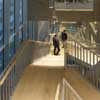
photograph : Jeroen Musch
MVRDV has collaborated with Norwegian co-architect DARK Arkitekter AS and various Norwegian engineering firms. Project management is executed by Norwegian firm Vedal Project AS. The second building of the DNB cluster is designed by A-lab and the third building by Dark Arkitekter, within the overall Bjørvika Barcode master plan. The cluster will be officially opened May 14th 2013.
DNB is the largest financial services group in Norway. The Group consists of brands such as DNB, Vital, Nordlandsbanken, Cresco, Postbanken, DnB NORD and Carlson. In 2003, MVRDV, together with Norwegian firms Dark and a-lab, won the competition for the Bjørvika waterfront development with the design of the Bjørvika Barcode; a dense, open and differentiated urban master plan along Nyland Allé, that is developed and realised by OSU in phases. DNB Life Insurance (DNB Scandinavian Property Fund) bought the 3 buildings last year for 4,8 billion Norwegian krone.
The internal route is furnished with seats, stairs and pantries ; Below the trading floor is a light space in the centre of the building:
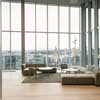
photograph : Jiri Havran
The internal route is furnished with seats, stairs and pantries. Image above Jiri Havran. Below the trading floor who is a light space in the centre of the building Images: Jeroen Musch
DNB Bank Headquarters main building images / information from MVRDV
DNB Bank Headquarters : MVRDV
DnB NOR Headquarters Oslo
Construction start for MVRDV designed headquarters building in Oslo, Norway
(Oslo, September 17, 2009): With the completion of the foundations up to basement level, the construction of the main building of the new DnB NOR headquarters in Norway, has entered its main phase. The new headquarter cluster with a total surface of 80,000m2, is developed by the Norwegian Oslo S Utvikling (OSU), and its central building, designed by MVRDV with 17 floors and a surface of 36,500m2, is due to be completed in 2012. The pixelated design adapts to the urban context and combines an efficient and flexible internal organisation, based on small-scale working entities, with a variety of specific communal spaces, a sheltered public passage and respect for urban view lines.
In 2003, MVRDV, together with Norwegian firms Dark and a-lab, won the competition for the Bjørvika waterfront development and designed a dense urban master plan along Nyland Allé, the Oslo Barcode, that will be developed and realised by OSU in phases.
The international Norwegian financial institution DnB NOR decided to concentrate their twenty office locations currently dispersed over the city in the Barcode. In 2007, the master plan team was commissioned by developer OSU to design the urban concept. A new cluster of three volumes and a common basement with a 3,000m2 underground concourse, which interlinks the three buildings of the bank, was developed. MVRDV was commissioned as architect for the central building and co-responsible for the concourse.
The development of a new headquarter cluster is a strategic operation aiming for synergy and a clear identity. The objective was to translate the social and democratic character of the organisation into a building with excellent working conditions and spatial qualities. The structure is conceived as a steel ‘rack’ which permits adaptation to the flexible nature of the organisation.
The steel rack is wrapped in a stone skin, which adopts Norwegian environmental standards. It appears as a rock, a strong shape within the boundaries of the Barcode. The niches of this rock provide space for vegetation growth: the positioning of the pixels creates roof gardens or outside areas for every floor.
The generic office floors recline and are recessed in various places to reflect the urban context and to create communal indoor and outdoor areas and outstanding daylight conditions. At street level the building volume is opened by sheltered entrance zones, and intersected by a public passage leading to the Oslo Central Station. The pixelated design allows this specific response whilst being highly efficient and flexible. As a result, every floor of the building is both unique and generic: the pixelated volume makes the generic specific.
Besides more than 2,000 flexible work spaces the building contains a panoramic 140 seat canteen on the top level, the executive lounge with a view over the fjord, the board room, in the heart of the volume, DnB NOR’s trading room with 250 work stations, and the main entrance with a reception and access to the concourse. These collective elements are connected by a staggered continuous internal route of terraces, encouraging informal meetings and communication between employees.
The route meanders from the reception upwards through the building, connecting all office levels with the communal areas. A series of wooden stairs and bridges allow employees to switch levels or even to walk the 17 levels up to the canteen on one side of the building and down on the other side. The route accommodates communal areas to the office floors and is made homely with a series of pantries, informal meeting areas and fire places. It gives access to the various outdoor terraces and roof gardens. All these collective spaces are designed as glass pixels allowing views over the surroundings and transparency from the exterior. The route is naturally ventilated and has a high performance glass fit for the cold Norwegian winter.
On behalf of OSU, MVRDV collaborates with Norwegian co-architect DARK Arkitekter AS and various Norwegian engineering firms. Project management is executed by Norwegian firm Vedal Project AS. The second building of the DnB NOR cluster is designed by A-lab and the third building by Dark Arkitekter, all within the overall master plan and the Barcode urban master plan by MVRDV / DARK / a-lab. DnB NOR is the largest financial services group in Norway. The Group consists of brands such as DnB NOR, Vital, Nordlandsbanken, Cresco, Postbanken, DnB NORD and Carlson.
DnB NOR Headquarters Norway images / information from MVRDV
DnB NOR Headquarters : MVRDV
Location: Bjørvika, Oslo, Norway
Norwegian Architecture
Contemporary Norwegian Architecture
Norwegian Architectural Designs – chronological list
Oslo Architecture Tours by e-architect
Norwegian Architecture – Selection:
HerrerosArquitectos
Munch Museum Building Oslo
Oslo Operahouse – cultural building
Snøhetta
Oslo Operahouse
Barcode Development Oslo – Bjørvika Buildings
a-lab
Eco Cube Oslo
Comments / photos for the DnB NOR Headquarters Norway page welcome

